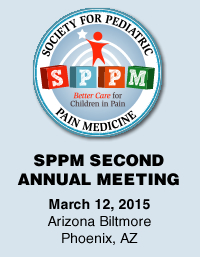A Message from the Second Annual Meeting Program Chair
 By Robert Wilder, MD, PhD
By Robert Wilder, MD, PhD
The Mayo Clinic, Rochester, MN
As life rushes me from one deadline to another, sometimes getting a good night’s sleep can be a casualty. A night or two of this certainly makes me appreciate the value of sufficient restful sleep. How tough is it then for our pain patients who have disrupted sleep almost every night? How do poor sleep habits effect pain, and how does pain affect ability to sleep? How do our medications affect sleep? Do tricyclic antidepressants improve sleep, or disrupt it. How about opioids? Does the duration of medication use matter? Our first session at the SPPM 2nd Annual Meeting will explore all these issues.
The second session looks at three clinical problems that periodically show up on the Pediatric Pain ListServe. First, what is the best way to monitor patients receiving parenteral opioids? Do we need to make capnography a routine monitor for pediatric patients? Does pulse oximetry help you or hurt you? If you are relying on clinical exam, what do you do with a patient who is asleep in the middle of the night? Do you need to awaken him or her? Second, how can you make a regional anesthesia practice work in the private practice setting? If your compensation depends on being in the operating room, how is coverage of the regional analgesia practice assigned between partners? Is a regional analgesia service cost effective?
Finally, is regional anesthesia appropriate for pediatric cardiac surgery? What do you do if you have blood in your epidural needle? Do you have to cancel the procedure for the day? Come with questions for our speakers. We hope that these topics will help improve pain management for our patients in a wide variety of settings.
I am very excited about our third session on Pediatric Palliative Care. Patients with chronic progressive illness and at the end of life are often very vulnerable to pain. Pain physicians often need to be intimately involved in palliative care services, and are often leaders of these services. This session will provide you with a better understanding of symptom management including pain, in palliative care. The second talk of the session will focus on helping children with pain that is not controlled with systemic opioids and adjunctive medications. A variety of regional analgesia techniques may be useful in improving quality of life for these patients and their families. This can be an overwhelmingly rewarding part of our practice. If your hospital does not have a pediatric palliative care service, take advantage of the workshop later for practical tips on how to set one up.
You will have a second chance to hear from some of our lecturers during the “Experts” session, where they will be presenting the best in the literature from the last couple of years.
During lunch we will have a wide variety of PBLDs, or if you need time to relax and reestablish your network of friends there will be time for that. Our late afternoon workshops are designed to provide help in improving your scope of practice: setting up a regional anesthesia service, setting up a palliative care service, and setting up a pain service overall. The Society for Pediatric Anesthesia will also be offering two perennial workshop favorites, acupuncture and ultrasound guided regional anesthesia, at the same time. Of course we hope that you will be able to stay for the Society for Pediatric Anesthesia meeting starting the next day.
The SPPM meeting is coming up soon. I am looking forward to seeing you all in warm and sunny Phoenix.

